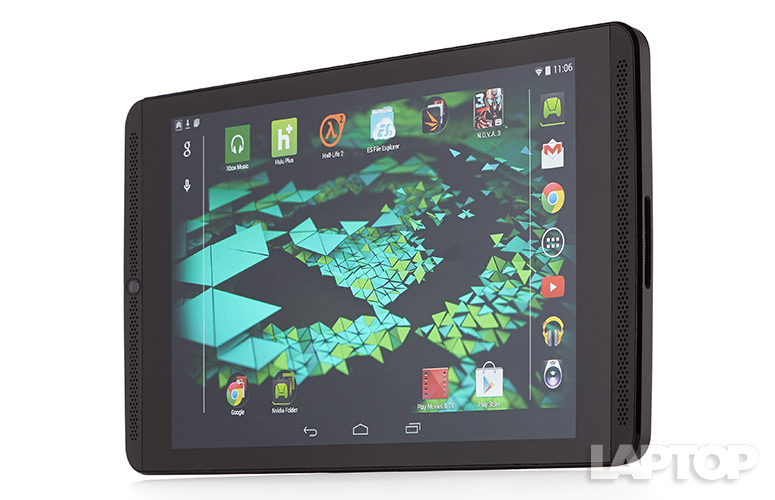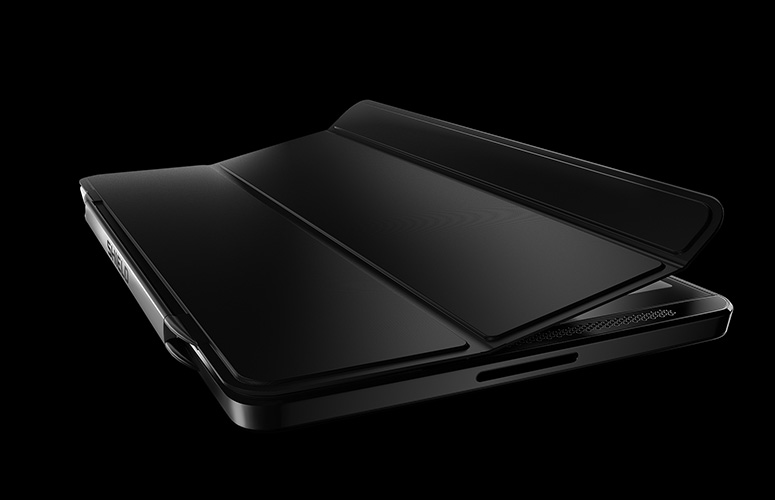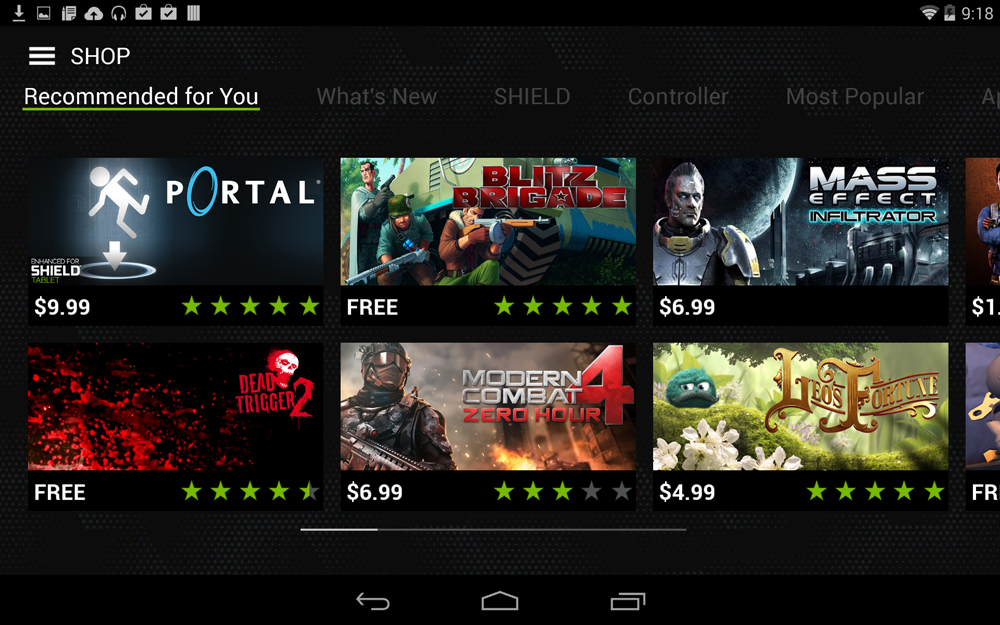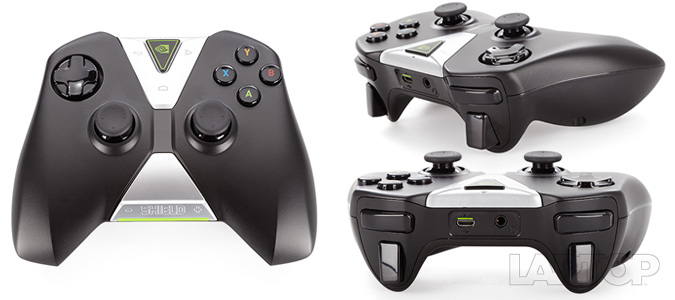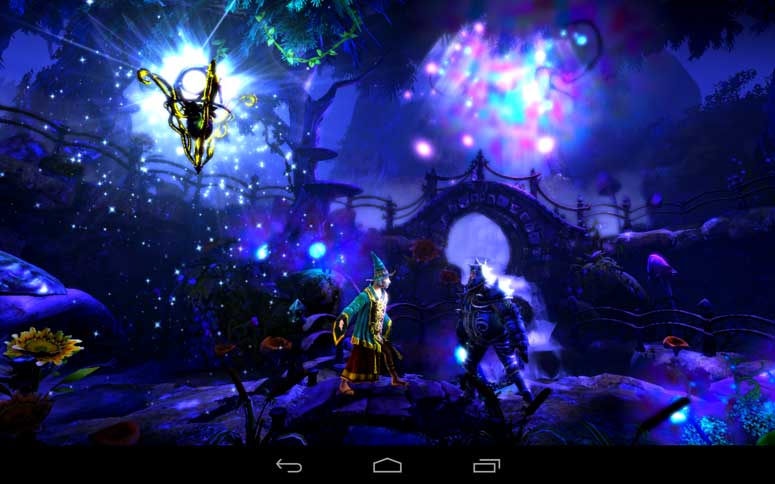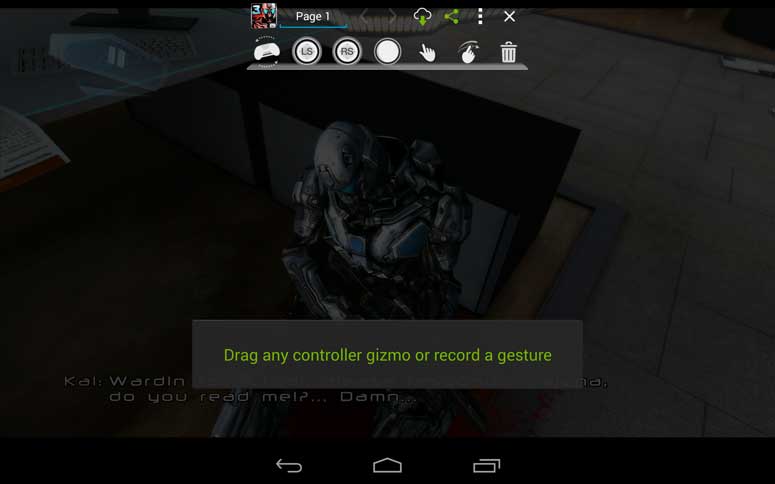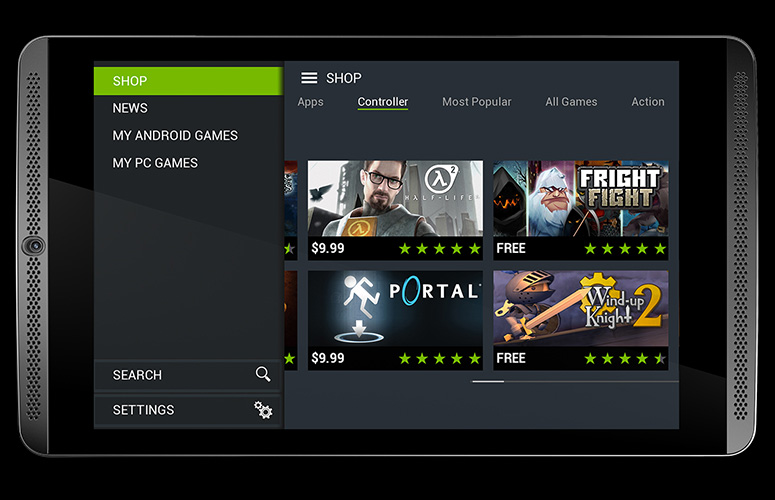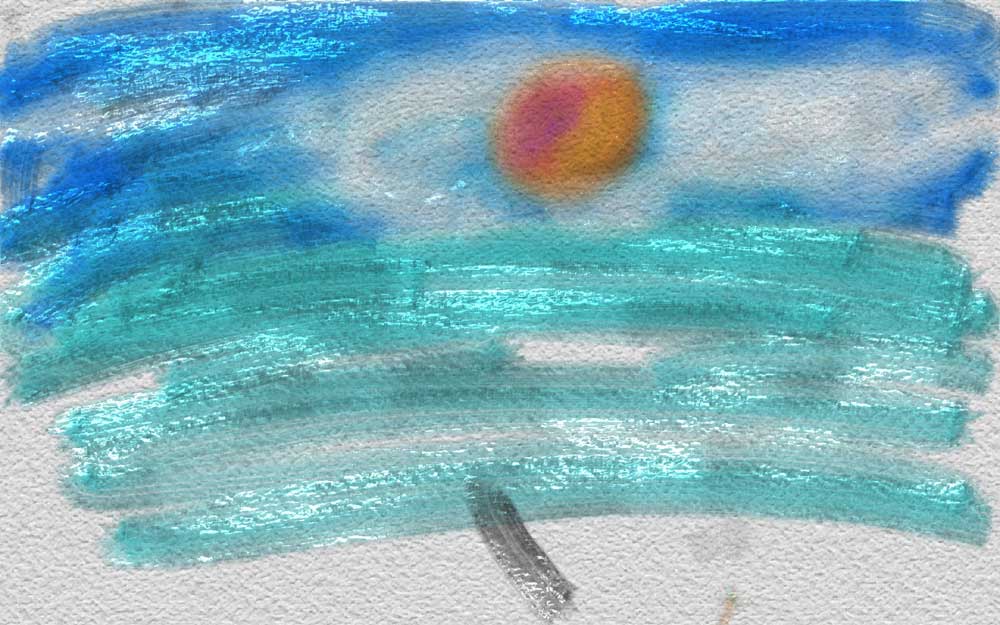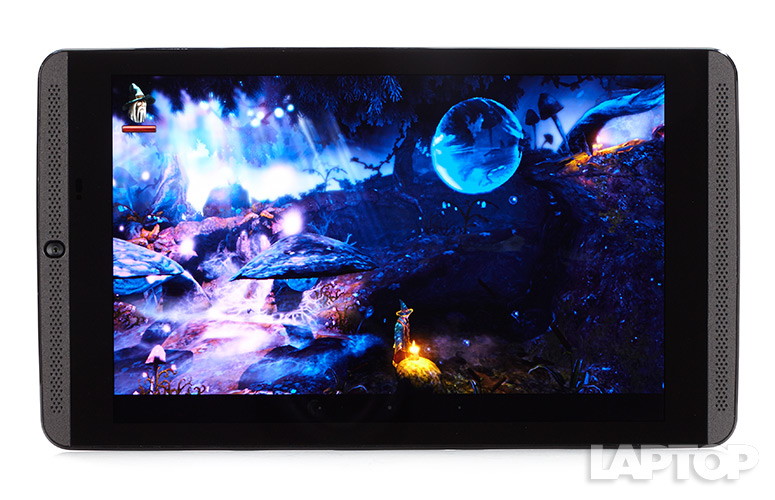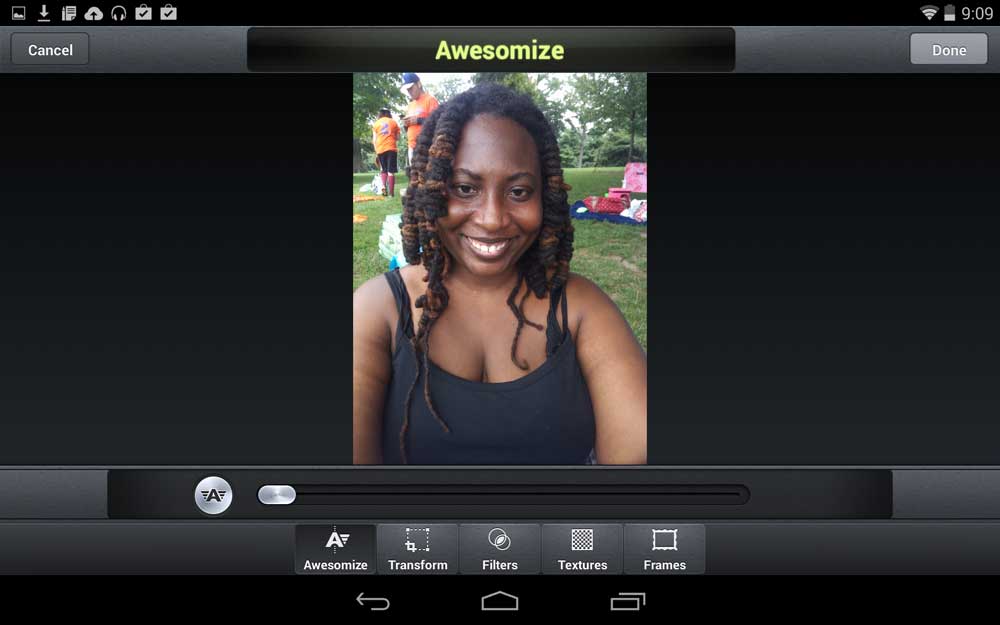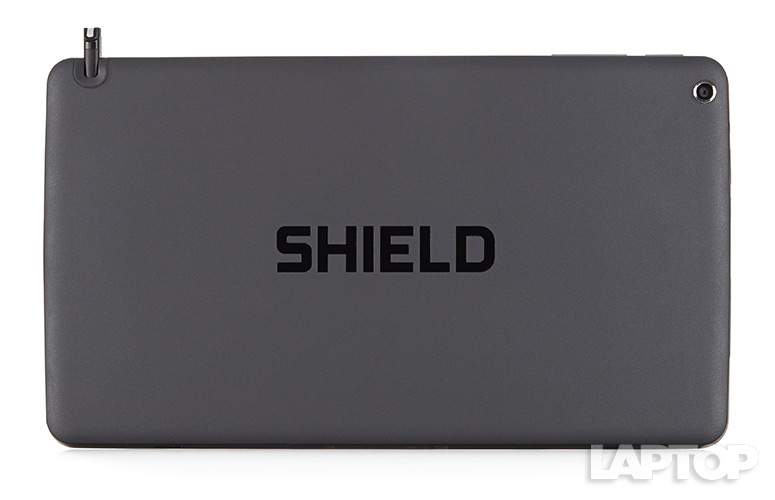Laptop Mag Verdict
The Nvidia Shield Tablet provides a kick-ass combination of features, including a very-fast K1 processor, game streaming and a versatile stylus.
Pros
- +
Sleek, clean design
- +
Beautiful display with vivid color
- +
Excellent graphics and overall performance
- +
Can stream Android and PC games
- +
Controller offers tight, accurate controls with low latency for Android and PC
- +
Long battery life
Cons
- -
Tablet and controller both bulky
- -
Expensive with accessories
Why you can trust Laptop Mag
The best answer to the question, "why not have both?," might come from Nvidia in the form of the Shield Tablet. Priced at $300, the company took the best attributes from the original Shield handheld gaming console (now rebranded as the Shield Portable) and the EVGA Tegra Note 7 and created a super gadget capable of delivering blistering performance and long battery life with a gorgeous 8-inch full HD display.
More than that, Nvidia has created a true gaming tablet that, combined with the $60 Shield Wireless Controller, can play both Android and PC games as well as livestream the fun to Twitch. Still, when you add the slate, controller and $30 stand cover, you'll pay close to the price of a PS4 or Xbox One. Is the Shield worth the scratch?
Editors' Note: Nvidia issued a voluntary recall of its 8-inch Shield tablets sold between July 2015 and July 2015. The tablets can overheat, posing a fire hazard. Nvidia will replace affected units with new ones.
[sc:video id="lodnE1cTqpNLdUStTScrn-grFGHx0grU" width="575" height="398"]
Design
It was love at first touch. The Shield Tablet's rear panel is swathed in a black, luxurious soft touch finish that's as nice to look at as it is to caress. A chrome-ringed 5-megapixel camera is located in the top right corner while the silver-tipped stylus rests in its plastic-lined holder at the top left corner. The glossy black Shield lettering in the center of the panel adds some nice shine and a bit of visual and textural contrast.
Turning the tablet around to the front reveals the 8-inch display surrounded by thick black bezels. Twin speakers flank the screen, and Nvidia placed another 5-MP camera in the middle of the left speaker housing.
Sign up to receive The Snapshot, a free special dispatch from Laptop Mag, in your inbox.
You'll find the power button and volume rocker on the top edge of the device along with port covers for the microSD and microSIM cards. A mini-HDMI port, microUSB port, headphone jack and a bass reflex port sit on the left edge along with a lone bass reflex port on the right. Last but not least is a pair of docking ports for the optional cover along the bottom.
As sleek as the Shield tablet looks, the 13.7-ounce, 8.8 x 5.0 x 0.36-inch device is positively bulky compared to most Android tablets. This includes the Samsung Galaxy Tab S 8.4 (10.37 ounces, 8.37 s 4.94 x 0.26 inches).
MORE: Most Anticipated Games of 2014
Display
Click to EnlargeIn a word, the Nvidia Shield Tablet's 1920 x 1200 display is lovely. The glossy panel delivered deep, gorgeous color with impressive detail. Viewing angles were generous, washing out only after I tilted the tablet away from my face.
As I watched the 1080p trailer for the upcoming James Brown biopic "Get On Up," I was treated to scene after scene of scrumptious reds, deep blues and vibrant greens. I couldn't stop staring at the individual tassels shimmying on Brown's ruby red jacket as he sauntered toward the stage.
Despite the vividness of the trailer, the Shield Tablet's screen is only capable of rendering 80 percent of the sRGB gamut. This falls below the 90.4 percent tablet average. The Tab S 8.4 in comparison, scored 160.5 percent. The Shield had better color accuracy, as its score of 3.4 on the Delta-E test beat the 5.25 average (numbers closer to 0 are better) and the Tab S 8.4's score of 4.5.
The Shield Tablet averaged 372 lux on our brightness test, slightly higher than the 361 lux tablet average. However, that doesn't hold a candle to the Tab S 8.9 (505 lux), Fire HDX 8.9 (465 lux) and iPad mini (390 lux). We had trouble viewing the Shield's display in direct sunlight.
Cover
Click to EnlargeIf you plan to play controller games on the tablet, you'll probably want to prop it up, which Nvidia makes easy with its $30 optional cover. The cover attaches to the tablet via a pair of docking ports along the bottom of the device and can be folded into a stand when it's time to start gaming. It also protects the display from scratches and dirt when closed.
Audio
What a difference a pair of front-facing speakers can make. When I listened to Pharrell's "Marilyn Munroe" on the Shield, the synthesized violin track filled the room. The singer's vocals were crisp as were the hand claps in the background. The side-mounted passive reflex bass ports delivered a surprising amount of thump, resulting in a healthy bassline.
You won't need an external speaker to hear your games or music from across the room. The tablet hit 85 decibels on our sound meter, beating the 79 dB average and the Tab S 8.4 (78 dB).
Interface
Click to EnlargeNvidia employs a light touch, keeping the Shield's UI as close to stock Android 4.4 (KitKat) as possible. Swiping down from the right opens the Quick Settings shade while swiping left from within this menu shows notifications. Quick Settings include Brightness, Wi-Fi, Battery, Fullscreen Mode and Shield Wireless controller.
The homescreen has folders for Google apps, Nvidia apps and icons for the Play Movies and the Play Store. Seven omnipresent icons (Camera!, Play Music, YouTube, Apps, Chrome, Gmail and Shield Hub) reside at the bottom as you swipe from screen to screen. With the exception of the Apps icon, every app can be swapped by dragging and dropping somewhere else.
Shield Apps
Click to EnlargeWith the Shield Tablet, it's all about the gaming experience. As its name suggests, Shield Hub houses a number of features, including an Android games shop, the latest Nvidia news and a catalog of all your PC and tablet games, as well as media apps like YouTube.
When it's time to take your gaming to a bigger screen, there's the Shield Console app. Using a mini-HDMI cable (not included), I had the option to display my tablet's output on my television via two modes, Mirror and Console.
Mirror mode is pretty self-explanatory, mirroring whatever's on the tablet in 1920 x 1200 pixels. Depending on what video you play, you might experience some letterboxing. When I streamed the latest episode of "Sailor Moon Crystal" on Hulu from the Shield Tablet, it didn't occupy the majority of the display. The actual mirror was essentially lag-free, streaming Sailor Moon's colorful transformation unabated.
Console Mode is perfect for those times when you want to play Android games such as Real Boxing or Dead Trigger 2 on your 1080p, 60-inch TV at 60 fps. However, Console Mode's biggest benefit is the ability to stream PC titles to your television in full HD. That allows gamers to bring their favorite pastime into the living room without lugging around a tower or huge gaming laptop.
Controller
Someone at Nvidia took the phrase, "go big or go home" a little too seriously. The $60 Shield Wireless Controller is absolutely massive. It's much wider than both the PlayStation 4 and Xbox One controllers. The overall design borrows heavily from the Shield Portable -- all you're missing is the 5-inch display bolted to the top of the device.
The front of the controller mixes traditional gaming inputs with Android-centric fare. A glossy plastic D-pad and shiny face buttons (Y, X, B and A) flank a plastic silver V with touch controls for Back, Home and Play/Pause. The triangular Nvidia-branded button pairs the device to the tablet and launches the Shield Hub.
Dual analog sticks occupy the center of the controller. A silver plastic triangle with the Shield insignia near the bottom of the peripheral acts as the volume control. A pair of triggers and bumpers sit atop the device with a headset jack and a microUSB port in the center.
Gameplay
Click to EnlargeThe Shield wireless controller isn't the prettiest peripheral, but it's one of the most useful. According to Nvidia, it's the first precision controller designed for Android and PC. Not only can you create your own custom controls, but also navigate the Shield Tablet and even use voice search.
On top of all that, you can plug in a headset controller and trash talk your opponents. Trust me, you haven't lived until you pwned someone in Titanfall with only your skill, a tablet and this controller attached to a headset. But if that isn't your bag, a simple button press will launch the preloaded Twitch app so you can narrate your upcoming victory. But all that's for nothing if the actual gameplay is garbage.
I'm happy to report that Nvidia has created one of the best wireless controllers I've had the pleasure of fragging with. It's not as good as the Xbox 360, which is considered the gold standard in many gaming circles, but it's in my top 10.
All of the buttons are nice and springy, delivering audible clicks. The bumpers and triggers are especially nice, giving firm, snappy feedback compared to the somewhat mushy response of the Xbox One's controller. The dual analogue sticks are accurate, and my thumbs fit comfortably into the concave hollows. However, I prefer the deep ridges lining the outside of the Xbox One controller, which have a better grip.
Thanks to the Wi-Fi Direct connection there was barely any latency, whether I was playing an Android game on the tablet or streaming via the tablet to my TV.
Despite the beefier dimensions, the Shield controller is pretty comfortable. I played Half-Life 2 for over two hours without any hand cramps or bruised fingers. Still, it would have been nice if Nvidia had found a way to trim the fat.
GamePad Mapper
Click to EnlargeEven though the Shield Wireless Controller should work with most games, there's always an exception. For those cases, Nvidia has preloaded the peripheral with the GamePad Mapper software. As it does on the Shield Portable, Mapper allows gamers to set certain in game actions to a corresponding key on the controller.
After accessing the software by pressing the Play/Pause button for two seconds and selecting Edit Mapper, a small overlay appeared. I had the option of simply dragging a move onto my button of choice in the overlay.
For more precise movesets, Mapper lets you record a series of actions that can be assigned to a button. While most Android games won't need this option, I could definitely picture fighting game aficionados mapping their favorite super moves and combos to certain buttons.
GameStream
Click to EnlargeSimilar to the PlayStation Vita Slim's Remote Play feature, GameStream gives gamers the ability to play 100 of the hottest PC games on the Shield Tablet. These titles include Assassin's Creed IV: Black Flag, Batman: Arkham Origins and Titanfall. GameStream will also accommodate unsupported games, but they have to be added manually.
Using a local network, gamers can just stream the game from a connected PC and game in any room of the house. The feature can also be used in tandem with Console Mode to stream your game into the living room.
However, getting GameStream set up takes some high powered hardware that not everyone will have. For example, desktops must have at least a GeForce GTX 660 GPU while notebooks have to feature at least a GeForce GTX 700M chip. Notebook GPUs are off the table if you want to stream in 1080p at 60 fps. For that, gamers have to have an Intel Core i5 or higher, or AMD FX 6-Core or higher with at least a desktop GeForce GTX 660 GPU.
In terms of processors, Nvidia set the entry point at either an Intel Core i3-2100 3.1GHz or AMD Athlon II X4 630 2.8-GHz or higher with at least 4GB of RAM. The company also has a list of suggested routers that ensure smooth streaming
Once you've compiled all the necessary specs, setup is relatively easy. After launching the Shield Hub app on the tablet, I went to the My PC Games tab and hit the GameStream button. Once the tablet discovered my PC, it generated a code for me to type into the PC's GeForce Experience control panel. I was all set.
Keep in mind that all the PS Vita needs is a PlayStation 3 or 4 and a decent Wi-Fi connection to begin playing Assassin's Creed IV on your Vita. Scavenger hunt aside, It was thrilling to play Titanfall at my desk with a tablet that could easily be concealed if my boss walked by.
All in all, that's still a lot of work to be stuck in your house. However Nvidia is currently testing a remote version of GameStream that will allow gamers to stream games to the tablet from the PC outside their local network.
I used the Shield controller to game, but you can use the tablet's touchscreen to control the action. However using pinch-zoom and two-finger scroll or a virtual keyboard in fast paced games such as Borderlands 2 or Titanfall is a sure-fire way to get your head blown off. I suggest sticking with the controller at all costs.
Stylus
Click to EnlargeNvidia's DirectStylus technology has been upgraded to DirectStylus 2.0, relying on the tablet's GPU instead of the processor to tell the difference between the pen and a finger. The upgraded tech also has handwriting recognition capabilities, allowing writers to perform Google searches by writing down the query instead of typing.
I was impressed with the accuracy and fluidity of Nvidia's stylus. Whether I wrote in my scrawling print or third-grade-level cursive, the device kept up with my crossed t's, dotted i's and superfluous curlicues with ease.
The palm rejection is top-notch, even without activating the Stylus-only mode. It allowed me to assume a more natural writing position compared to other devices I've tested. Lefties will be glad to hear that Nvidia included a setting to accommodate them.
The handwriting recognition is solid as the tablet accurately transcribed my scribbles into text on most occasions.
Stylus Apps
Click to EnlargeInstead of leaving you to hunt for pen-friendly apps, Nvidia took the liberty of compiling a few for you. Once I removed the stylus from its holster, the Nvidia DirectStylus Launcher opened, revealing the Nvidia Dabbler, Write, Evernote and JustWrite apps. There's also a Settings icon and an Add icon, allowing me to add or remove apps as I see fit.
The Write app is pretty straight-forward, offering a quick, no-fuss way to jot down a note or two. Taking a page from Samsung, Write has a web view that splits the screen in two, allowing writers to peruse Google and take notes simultaneously.
Just Write is a to-do list combined with a personal organizer. Using a series of folders, I planned out my week via a few folders I created (To-Do, Work Related, Weekend Plans). After choosing a specified day, I double tapped to select which folder I would use. From there, I wrote in the task (walk Xerxes, my dog) and saved. Once the reminder was created, I tapped twice on the gray clock to select the correct time and choose whether it should be a recurring reminder.
I'm not much of an artist, but Nvidia Dabbler is by far the most compelling app in Nvidia's pen-based stable. Dubbed as the world's first GPU accelerated 3D Painting application, the app provides painters and illustrators with a digital canvas, complete with oil and watercolor paint effects.
Click to EnlargeAs I made my rudimentary strokes in watercolor mode, I loved the way the "paint" expanded as it soaked into the canvas as well as the way it paint appeared to drip down the screen when the tablet was propped up. I was equally impressed with how realistically the oil paint layered itself as I painted my interpretation of a mid-day sun over the ocean. More advanced painters will appreciate the paint-mixing functions, as well as the dynamic lighting effects.
MORE: Best Android Sports Games
Performance
Click to EnlargeSporting a 2.2-GHz, quad-core Tegra K1 CPU with 2GB of RAM, the Nvidia Shield Tablet delivers fast app launches and swift menu navigation--with plenty left in the tank for all your gaming needs. Running and gunning aliens in N.O.V.A 3 was smooth as silk. But I was really impressed when I started streaming Half-Life 2. There was nary a jaggie or stutter in sight as I swung my trusty wrench.
The Shield Tablet got off to a strong start during the Geekbench 3 benchmark, which measures overall performance. On this test, the tablet blew away the field with a score of 3,437. The Samsung Galaxy Tab S 8.4 (1.9-GHz Samsung Exynos 5 Octa CPU) took a distant second with 2,768. The Amazon Kindle Fire HDX 8.9 (2.2-GHz Snapdragon 800 CPU) was right behind, notching 2,609. The Apple iPad Mini (Apple A7 CPU) scored the lowest at 2,519.
It took the Shield Tablet 4 minutes and 50 seconds to transcode an HD video to 480p using the Vidtrim app. That's more than twice as fast as the 11:25 average. The Tab S 8.4 was a couple of seconds faster at 4:48 while the HDX 8.9 finished in 4:19.
Not surprisingly, the Shield's 192-Core GPU with Kepler architecture excelled in graphics performance. The tablet hit a whopping 29,938 on the 3DMark Ice Storm Unlimited test, soundly beating the 9,972 average. The iPad Mini's 400-MHz Adreno 320 GPU was about half of powerful with 14,128. Behind them was the Tab S 8.4 (13,518) and Fire HDX 8.9 (12,786).
When I launched N.O.V.A. 3 on the Shield Tablet, it took only 12 seconds to load the game. The Tab S 8.4 took 16 seconds, while the iPad Mini launched the title in a blistering 5 seconds. This might be due to the iPad having a different OS than our Android tablets.
MORE: 12 Surprising Things Your Android Phone Can Do
Camera and Camcorder
Click to EnlargeFive is the magic number for Nvidia, at least when it comes to cameras. Both the front and rear camera on the Shield Tablet are 5 megapixels in resolution, good news for selfie addicts who usually get the short end of the stick.
I snapped a few shots of myself on a day trip and was pleasantly surprised at the color depth, particularly when it came to my skin tone and the reddish-brown streaks in my locs. The camera did a great job of capturing my coils and even a few errant eyebrow hairs (yikes!).
The rear camera was just as impressive, delivering accurate color and detail in a photo of a bouquet of flowers. The sunflower's golden yellow petals popped against its dark brown core. The scarlet roses looked full and opulent, but our favourite part of the shot was the pop of electric blue in the center. I could easily make out the myriad of veins in the green leaf in the lower right corner, as well as the individual disk florets on the sunflower.
Click to EnlargeThe color cavalcade continued in our 1080p test video of New York City traffic. A tour bus packed with people was a cornucopia of deep reds, varying shades of blue and a pop of mustard for good measure. The white text was sharp enough that I could read the company's phone number as well as the cross street for its location.
Although the Shield Tablet captures video in 1080p, it has the ability to stream in 4K, provided that you connect it to an Ultra HD monitor or TV via HDMI.
Click to EnlargeSimilar to the Tegra Note 7, the Shield Tablet utilizes the Camera! Awesome app, which can automatically color correct images. The app also has a pre-record feature that takes up to five seconds of video before you actually press the record button. This definitely came in handy when I tried to get video of my dog Xerxes looking into the camera. There's also a slow-mo mode if you're a fan of time lapse shots.
[sc:video id="AyazFncTrWLUDeVgw2-66yTM7yBo6CWn" width="575" height="398"]
Battery Life
The Nvidia Shield Tablet lasted 8 hours and 34 minutes on the Laptop Mag Battery Test which invovles continuous web surfing over Wi-Fi at 150 nits of brightness. That was enough to top the 8:19 tablet average as well as the Samsung Galaxy Tab S 8.4's 7:56. However, the Shield was no match for the iPad mini with Retina or the Amazon Fire HDX 8.9, which lasted 11:06 and 13:42, respectively.
MORE: 10 Tablets with the Longest Battery Life
Configurations
The Nvidia Shield Tablet I reviewed is the Wi-Fi configuration priced at $299. It features a 2.2-GHz Tegra K1 CPU, 2GB RAM and 16GB of flash storage..
For gamers looking for mobile connectivity, there's the $399 4G LTE version which has all the same specs as the Wi-Fi model but bumps up the storage to 32GB. Keep in mind, that the tablet will only work on AT&T and T-Mobile's networks.
Bottom Line
Click to EnlargeAt first I was pretty skeptical of the Shield Tablet's appeal. I knew Nvidia could make a powerful slate, but could it truly satisfy its niche? Based on my testing, the company has found a way to harness the Tegra K1's muscle to take mobile gaming to the next level. The PC streaming capabilities are especially satisfying, although it works only within the home (for now) and only if your PC meets Nvidia's standards.
The $300 base price for the tablet is fairly affordable, but the cost becomes steep when you throw in the $60 controller and the $30 cover. At that point, you're just $10 shy of today's next-gen consoles. Then again, the Shield Tablet runs circles around the $399 Galaxy Tab S 8.4 in terms of speed, and it comes with a versatile stylus. if you want both an Android tablet and a powerful gaming system together, the Nvidia Shield Tablet is a device you shouldn't pass up.
Nvidia Shield Tablet Specs
| Brand | Nvidia |
| CPU | 2.2-GHz Tegra K1 |
| Camera Resolution | 5MP |
| Card Reader Size | 128GB |
| Card Readers | microSD, micro SIM |
| Company Website | www.nvidia.com |
| Display Resolution | 1920 x 1200 |
| Display Size | 8 |
| Front-Facing Camera Resolution | 5MP |
| Graphics Chip | 192 cores, Kepler architecture |
| OS | Android 4.4.2 |
| Ports | Microphone/Headphone, Docking Port, Mini-HDMI, microUSB |
| RAM Included | 2GB |
| RAM Upgradeable | 2GB |
| Size | 8.8 x 5.0 x 0.36 inches |
| Storage Drive Size | 16GB |
| Storage Drive Type | Flash Memory |
| USB Ports | 1 |
| Weight | 13.7 ounces |
| Wi-Fi | 802.11a/b/g/n |

Sherri L. Smith has been cranking out product reviews for Laptopmag.com since 2011. In that time, she's reviewed more than her share of laptops, tablets, smartphones and everything in between. The resident gamer and audio junkie, Sherri was previously a managing editor for Black Web 2.0 and contributed to BET.Com and Popgadget.

